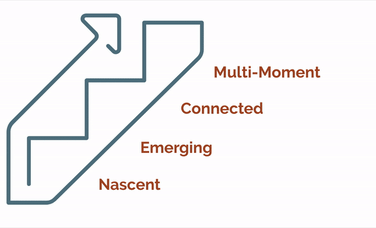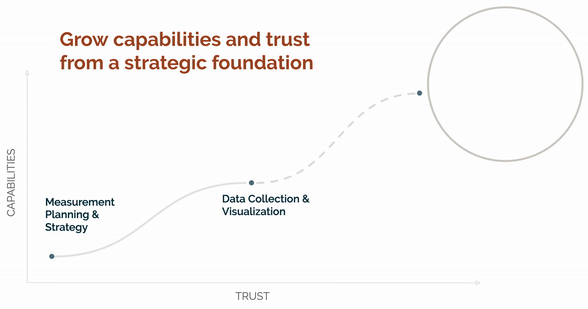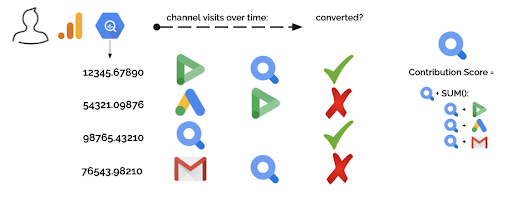On-Demand
Featuring
Subscribe to our monthly newsletter to get the latest updates in your inbox
Adswerve was recently honored to contribute to this Google webinar about Digital Maturity and share how we help our clients assess their existing capabilities. You can also access the webinar slides here. Before we dive into what we discussed, let’s shed some light on
Google’s Digital Maturity Framework
.
An Intro to Google’s Digital Maturity Framework
 Developed in partnership with Boston Consulting Group (BCG), Google’s benchmark is a diagnostic tool that informs where your business sits on the path to full data-driven marketing and attribution. Google and BCG identified four stages on the Digital Maturity scale, including:
Developed in partnership with Boston Consulting Group (BCG), Google’s benchmark is a diagnostic tool that informs where your business sits on the path to full data-driven marketing and attribution. Google and BCG identified four stages on the Digital Maturity scale, including:
 Step 1: Building a Solid Foundation
The first step on our Capabilities Framework involves building a strategic foundation through
Measurement Planning and Strategy.
Building this foundation involves:
Step 1: Building a Solid Foundation
The first step on our Capabilities Framework involves building a strategic foundation through
Measurement Planning and Strategy.
Building this foundation involves:
 Throughout this process, we help our clients understand that data collection is informed by strategy (like taking the above strategic steps) and strategy is informed by reality. To help reveal reality, we’ve built tools to drill into our analytics platforms with high-fidelity analysis. For example:
Throughout this process, we help our clients understand that data collection is informed by strategy (like taking the above strategic steps) and strategy is informed by reality. To help reveal reality, we’ve built tools to drill into our analytics platforms with high-fidelity analysis. For example:
 With the Google Cloud Platform in place, we can easily turn on BigQuery (BQ) to build a data-driven attribution model:
With the Google Cloud Platform in place, we can easily turn on BigQuery (BQ) to build a data-driven attribution model:
 Build your own data-driven, probabilistic multi-touch attribution model
using this Python Notebook
as a reference. The notebook transposes
Xuhui Shao’s Simple MTA method
using BQ and the GA export schema, Github code.
Conclusion
This journey may seem lengthy and complex, and you’re right — it is. But research into data-driven marketing maturity by Google and the Boston Consulting Group found that only 2% of businesses use insights and technology to create useful, relevant experiences at multiple moments across the purchase journey.
By building out a strategic foundation and unlocking the power of Google Cloud Platform and BQ, you can set your organization above the rest and drive real, sustainable competitive advantages. If you’re interested in learning more about how we’re helping clients like YETI drive multi-moment marketing optimized toward individual customer outcomes and transactions, please
reach out
! We’d love to help you move along the maturity framework. And don’t forget to check out the Google on-demand webinar for even more insights.
Build your own data-driven, probabilistic multi-touch attribution model
using this Python Notebook
as a reference. The notebook transposes
Xuhui Shao’s Simple MTA method
using BQ and the GA export schema, Github code.
Conclusion
This journey may seem lengthy and complex, and you’re right — it is. But research into data-driven marketing maturity by Google and the Boston Consulting Group found that only 2% of businesses use insights and technology to create useful, relevant experiences at multiple moments across the purchase journey.
By building out a strategic foundation and unlocking the power of Google Cloud Platform and BQ, you can set your organization above the rest and drive real, sustainable competitive advantages. If you’re interested in learning more about how we’re helping clients like YETI drive multi-moment marketing optimized toward individual customer outcomes and transactions, please
reach out
! We’d love to help you move along the maturity framework. And don’t forget to check out the Google on-demand webinar for even more insights.
 Developed in partnership with Boston Consulting Group (BCG), Google’s benchmark is a diagnostic tool that informs where your business sits on the path to full data-driven marketing and attribution. Google and BCG identified four stages on the Digital Maturity scale, including:
Developed in partnership with Boston Consulting Group (BCG), Google’s benchmark is a diagnostic tool that informs where your business sits on the path to full data-driven marketing and attribution. Google and BCG identified four stages on the Digital Maturity scale, including:
- Nascent: Marketing campaigns mainly use external data and direct buys, with limited links to sales.
- Emerging: There is some use of owned data in automated buying with single-channel optimization and testing.
- Connected: Data integrated and activated across channels with demonstrated link to ROI or sales proxies.
- Multi-Moment: Dynamic execution across multiple channels, optimized toward individual customer business outcomes and transactions.
 Step 1: Building a Solid Foundation
The first step on our Capabilities Framework involves building a strategic foundation through
Measurement Planning and Strategy.
Building this foundation involves:
Step 1: Building a Solid Foundation
The first step on our Capabilities Framework involves building a strategic foundation through
Measurement Planning and Strategy.
Building this foundation involves:
- Stakeholder Interviews: Gathering feedback throughout the entire organization; defining requirements and documenting gaps and successes
- Cross-Team Coordination: Defining what collaboration across business units looks like and understanding what data outputs are shared
- Audit Existing Collection: Reviewing existing collection implementation and analyzing historical data.
- Audit Existing Capabilities: Surfacing and reviewing descriptive statistics on data and labeling feature weights with Machine Learning (ML) processing.
 Throughout this process, we help our clients understand that data collection is informed by strategy (like taking the above strategic steps) and strategy is informed by reality. To help reveal reality, we’ve built tools to drill into our analytics platforms with high-fidelity analysis. For example:
Throughout this process, we help our clients understand that data collection is informed by strategy (like taking the above strategic steps) and strategy is informed by reality. To help reveal reality, we’ve built tools to drill into our analytics platforms with high-fidelity analysis. For example:
- To uncover the quality of our client’s data, we apply unsupervised learning techniques to analyze highly cardinal/dimensional data sets.
- To determine if Google Analytics data is actionable and clean, we perform health checks and audits. You can do this, too, through our free Google Data Studio Report.
- To inspect Google Analytics activity and monitor dataLayer in real-time, we’ve built a free Data Layer Inspector+ Chrome Extension.
- To test capabilities, we clean and prepare data for use in prediction pipelines, assessing feature importance and weights, and then sharing the source code in a Python Notebook.
 With the Google Cloud Platform in place, we can easily turn on BigQuery (BQ) to build a data-driven attribution model:
With the Google Cloud Platform in place, we can easily turn on BigQuery (BQ) to build a data-driven attribution model:
- BQ allows us to store unlimited amounts of data from different data sources we need for attribution purposes
- We have the ability to effortlessly process an unlimited amount of data with the power of SQL to create datasets for the attribution model
- We can use BQ ML right inside BQ to build ML model without even leaving the tool
- BQ represents a “one shop stop” where we can efficiently work with large amounts of data which saves a huge amount of time
 Build your own data-driven, probabilistic multi-touch attribution model
using this Python Notebook
as a reference. The notebook transposes
Xuhui Shao’s Simple MTA method
using BQ and the GA export schema, Github code.
Conclusion
This journey may seem lengthy and complex, and you’re right — it is. But research into data-driven marketing maturity by Google and the Boston Consulting Group found that only 2% of businesses use insights and technology to create useful, relevant experiences at multiple moments across the purchase journey.
By building out a strategic foundation and unlocking the power of Google Cloud Platform and BQ, you can set your organization above the rest and drive real, sustainable competitive advantages. If you’re interested in learning more about how we’re helping clients like YETI drive multi-moment marketing optimized toward individual customer outcomes and transactions, please
reach out
! We’d love to help you move along the maturity framework. And don’t forget to check out the Google on-demand webinar for even more insights.
Build your own data-driven, probabilistic multi-touch attribution model
using this Python Notebook
as a reference. The notebook transposes
Xuhui Shao’s Simple MTA method
using BQ and the GA export schema, Github code.
Conclusion
This journey may seem lengthy and complex, and you’re right — it is. But research into data-driven marketing maturity by Google and the Boston Consulting Group found that only 2% of businesses use insights and technology to create useful, relevant experiences at multiple moments across the purchase journey.
By building out a strategic foundation and unlocking the power of Google Cloud Platform and BQ, you can set your organization above the rest and drive real, sustainable competitive advantages. If you’re interested in learning more about how we’re helping clients like YETI drive multi-moment marketing optimized toward individual customer outcomes and transactions, please
reach out
! We’d love to help you move along the maturity framework. And don’t forget to check out the Google on-demand webinar for even more insights.Registration for this webinar is now closed. Check back soon for on-demand access.
%20(1).png?width=2500&height=1667&name=Portal%20Drop%20Down%20(1)%20(1).png)